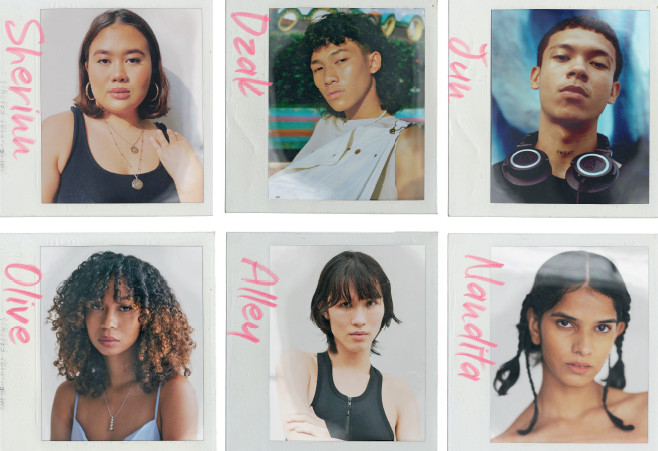A DIVERSITY REPORT ON THE FALL/WINTER 2020 RUNWAY SEASON BY THE FASHION SPOT – DRAWN FROM 194 SHOWS THAT TOOK PLACE IN THE FOUR MAJOR FASHION WEEK CITIES – FOUND THAT 40.6 PER CENT OF MODELS CAST WERE PEOPLE OF COLOUR.


FEAT. ARTISTS, MUMBAI, INDIA
“The time of just the clothes horse has come to an end,” declares Smita Lasrado of Feat. Artists, a model and talent agency based in Mumbai, India that she co-founded in 2018 with stylist Nikhil Dudani. What she means is that the fashion industry these days expects more than interchangeable canvases. Instead, Feat. prides itself on scouting and representing “all the young, amazing cool kids in India of all genders, ethnicities, body types and ages”.
The notion of beauty that the agency is pushing is broad. “India is such a diverse and vast country in terms of how people look. We want to highlight these different realities of what an Indian person can look like,” says Lasrado. Yet the vastness of her home country does also mean that change doesn’t always come quick. “(Getting people to understand and appreciate such diversity) is a slow process and requires a lot of dismantling, but it’s in motion.”
This is particularly important considering that India’s fashion industry is set to grow to US$59.3 billion (S$80.5 billion) by 2022, making it the sixth largest in the world, according to a McKinsey report. And Lasrado feels that India – what with it set to play a bigger part in the international fashion scene – is quickly catching up to leading cities in managing a sophisticated bridge between commercial and editorial work.

THE MODELS LAB, KUALA LUMPUR, MALAYSIA
Ayyman Rahim, the founder of KL-based The Models Lab, recalls that up to 2018, close to 90 per cent of models in Malaysia were freelancers. They did not work with agencies that helped them place clients, manage scheduling, negotiate fees and contracts – things necessary for a model’s professional development. “It was a shame,” says Ayyman. “There are incredible talents in the local modelling scene and they weren’t managed properly, affecting the quality of their work.”
Fast forward to 2020 and The Models Lab now represents 16 models, working with pride in and the belief that the prestige of local models should be uplifted. According to Ayyman, the wage gap between Asian and European models in Malaysia is “undeniable” with treatment of them equally different. Local models, he says, tend to be paid less – a fact that he’s trying to change. This issue is shaped by longheld beauty standards, he posits – ones that he calls a “generational notion”.
The qualities Ayyman seeks in his models buck tradition. Height, for one, is not crucial. “Being tall doesn’t do much if you can’t carry yourself well,” he quips. Models today are also expected to do more than just pose for photos and walk the runway. On his roster are people like Natalie Prabha, an advocate for sustainability and vegan lifestyles; Batrisyia Razak, a Tiktok comedian; Nia Atasha and Rita Nadira, who act and host; and Cyii Cheng, who upcycles thrifted clothes.
He describes a recent fashion show (pre-Covid) by Malaysian designer Adila Long that was modelled by a cast of 16 local models as “a breath of fresh air”. Even if the industry is “wary and doubtful” of local models, he’s optimistic about the progress of diversity in the country. “Malaysia still has a long way to go and I’m trying to change that.”

MISC. MANAGEMENT, SINGAPORE
Management got its start from a “why not?” moment in 2018. Li Wanjie, who founded Misc. with Timothy Tan, describes it as “a proposition” that works in gentle resistance to business. “Other agencies cast based on what the industry wants, but what we offer is what we think it should look like,” he says. What started out as a roster of three models is now 24-strong.
The company aims to disrupt, scouting with a keen eye for models of minority races and the like; many of them creatives. A photographer himself, Li parlays an understanding of image-making to support work that proposes new ways of looking at and understanding beauty.
More than just exercises in creativity though, Misc. is on a mission to influence the casting of productions in Singapore. It’s only been in recent years that local models have again started fronting magazine covers, recalling the industry in the ’80s and ’90s – often thought of as the golden age of the Singapore model. In that two- to three-decade interim, the practice of placements that saw foreign models flown in to work for a few months before rotating out to another city took over. Practices like that “makes little sense in a post-Covid world where international travel isn’t such a breeze”, says Li. “It won’t hold and it’s too expensive.”























